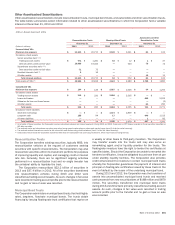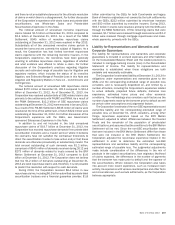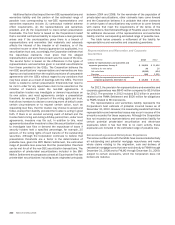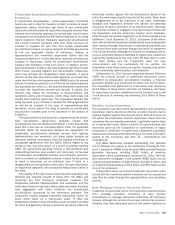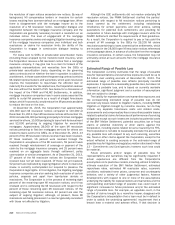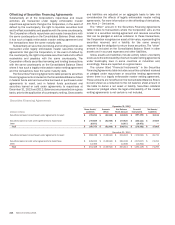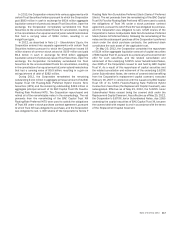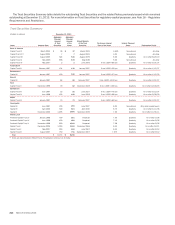Bank of America 2013 Annual Report Download - page 211
Download and view the complete annual report
Please find page 211 of the 2013 Bank of America annual report below. You can navigate through the pages in the report by either clicking on the pages listed below, or by using the keyword search tool below to find specific information within the annual report.Bank of America 2013 209
Private-label Securitizations and Whole-loan Sales
Experience
In private-label securitizations, certain presentation thresholds
need to be met in order for investors to direct a trustee to assert
repurchase claims. Continued high levels of new private-label
claims are primarily related to repurchase requests received from
trustees and third-party sponsors for private-label securitization
transactions not included in the BNY Mellon Settlement, including
claims related to first-lien third-party sponsored securitizations
that include monoline insurance. Over time, there has been an
increase in requests for loan files from certain private-label
securitization trustees, as well as requests for tolling agreements
to toll the applicable statute of limitations relating to
representations and warranties repurchase claims and the
Corporation believes it is likely that these requests will lead to an
increase in repurchase claims for private-label securitization
trustees with standing to bring such claims. In addition, private-
label securitization trustees may have obtained loan files through
other means, including litigation and administrative subpoenas,
which may increase the Corporation’s total exposure. A recent
decision by the New York intermediate appellate court held that,
under New York law, which governs many RMBS trusts, the six-year
statute of limitations starts to run at the time the representations
and warranties are made (i.e., the date the transaction closed and
not when the repurchase demand was denied). If upheld, this
decision may impact the timeliness of representations and
warranties claims and/or lawsuits, where these claims have not
already been tolled by agreement. The Corporation believes this
ruling may lead to an increase in requests for tolling agreements
as well as an increase in the pace of representations and
warranties claims and/or the filing of lawsuits by private-label
securitization trustees prior to the expiration of the statute of
limitations.
The representations and warranties, as governed by the private-
label securitization agreements, generally require that
counterparties have the ability to both assert a claim and actually
prove that a loan has an actionable defect under the applicable
contracts. While the Corporation believes the agreements for
private-label securitizations generally contain less rigorous
representations and warranties and place higher burdens on
claimants seeking repurchases than the express provisions of
comparable agreements with the GSEs, without regard to any
variations that may have arisen as a result of dealings with the
GSEs, the agreements generally include a representation that
underwriting practices were prudent and customary. In the case
of private-label securitization trustees and third-party sponsors,
there is currently no established process in place for the parties
to reach a conclusion on an individual loan if there is a
disagreement on the resolution of the claim. For more information
on repurchase demands, see Unresolved Repurchase Claims in
this Note.
The majority of the repurchase claims that the Corporation has
received and resolved outside of those from the GSEs and
monolines are from third-party whole-loan investors. The
Corporation provided representations and warranties and the
whole-loan investors may retain those rights even when the loans
were aggregated with other collateral into private-label
securitizations sponsored by the whole-loan investors. The
Corporation reviews properly presented repurchase claims for
these whole loans on a loan-by-loan basis. If, after the
Corporation’s review, it does not believe a claim is valid, it will deny
the claim and generally indicate a reason for the denial. When the
whole-loan investor agrees with the Corporation’s denial of the
claim, the whole-loan investor may rescind the claim. When there
is disagreement as to the resolution of the claim, meaningful
dialogue and negotiation between the parties are generally
necessary to reach a resolution on an individual claim. Generally,
a whole-loan investor is engaged in the repurchase process and
the Corporation and the whole-loan investor reach resolution,
either through loan-by-loan negotiation or at times, through a bulk
settlement. As of December 31, 2013, 16 percent of the whole-
loan claims that the Corporation initially denied have subsequently
been resolved through repurchase or make-whole payments and
44 percent have been resolved through rescission or repayment
in full by the borrower. Although the timeline for resolution varies,
once an actionable breach is identified on a given loan, settlement
is generally reached as to that loan within 60 days. When a claim
has been denied and the Corporation does not have
communication with the counterparty for six months, the
Corporation views these claims as inactive; however, they remain
in the outstanding claims balance until resolution.
At December 31, 2013, for loans originated between 2004 and
2008, the notional amount of unresolved repurchase claims
submitted by private-label securitization trustees, a financial
guarantee provider and whole-loan investors was $17.9 billion.
The Corporation has performed an initial review with respect to
$14.6 billion of these claims and does not believe a valid basis
for repurchase has been established by the claimant and is still
in the process of reviewing the remaining $3.3 billion of these
claims.
Monoline Insurers Experience
The Corporation has had limited representations and warranties
repurchase claims experience with the monoline insurers due to
ongoing litigation against Countrywide and/or Bank of America. To
the extent the Corporation received repurchase claims from the
monolines that are properly presented, it generally reviews them
on a loan-by-loan basis. Where a breach of representations and
warranties given by the Corporation or subsidiaries or legacy
companies is confirmed on a given loan, settlement is generally
reached as to that loan within 60 to 90 days. For more information
related to the monolines, see Note 12 – Commitments and
Contingencies.
The MBIA Settlement resolved outstanding and potential
claims between the parties to the settlement involving 31 first-
and 17 second-lien RMBS trusts for which MBIA provided financial
guarantee insurance, including $945 million of monoline
repurchase claims outstanding at December 31, 2012. The first-
and second-lien mortgages in the covered RMBS trusts had an
original principal balance of $29.3 billion and $25.5 billion, and
an unpaid principal balance of $9.8 billion and $9.3 billion at the
time of the settlement.
During 2013, there was minimal loan-level repurchase claim
activity with the monolines and the monolines did not request any
loan files for review through the representations and warranties
process.
Open Mortgage Insurance Rescission Notices
In addition to repurchase claims, the Corporation receives notices
from mortgage insurance companies of claim denials,
cancellations or coverage rescission (collectively, MI rescission
notices). Although the number of such open notices has remained
elevated, they have decreased over the last several quarters as




